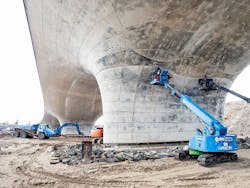In the Netherlands, nearly half the land is below sea level. The city of Nijmegen (pronounced nie-may-ghen) sits on the eastern waterfront of the country, alongside a sharp bend that forms a bottleneck in one of their largest rivers: the Waal. In the 1990s, heavy rains and this bottleneck caused severe floods in the city. With greater risk of extreme weather and flooding brought on by climate change, the only way for Nijmegen to protect itself from future damage is by implementing flood-protection programs. In 2011, one such program, “Ruimte voor de Waal,” (which translates to “room for the Waal”), began drafting plans to move existing dikes and levees, and dig a second 2.5-mile-long riverbed.
The General Director of the Netherlands Public Works and Water Management, Jan Hendrik Dronkers, wisely stated, “Fighting against water is no longer the way to keep the Netherlands secure and livable. In this country, we must learn to live with water by giving it a place in our daily lives. Safety is still paramount in our water management, but ‘building with nature’ is the credo nowadays.”
The aim was to turn a portion of the suburb of Lent into an island, connected to both banks of the river by three bridges. Because the people living in this area would be displaced, the project faced initial backlash, but the value for future security against flooding won out. The town planners had to consider extensive changes to the city infrastructure, with the primary goal of redirecting the course of the river via an additional channel. The existing Waal bridge was extended by several hundred yards, built not as much with traffic in mind, but for the flow of water underneath. Two new bridges also were erected: The Citadel Bridge, connecting the mainland to the western part of the island, and the Promenade Bridge, which connects the mainland with the center of the island. The engineers involved faced an enormous challenge at this scale, especially since construction on all three bridges was expected to be completed and ready within a three-year period.
The successful delivery of this project relied heavily on building information modeling (BIM) software. The team of 10 designers and 10 engineers used Allplan software to create a 3D model of the formwork and reinforcement for the bridges. This allowed the work to be done more quickly and efficiently for the teams involved. All relevant information was derived and shared from the 3D model, such as views and sections, reports for steel and bending schedules, or volumes of ready-mixed concrete—automatically generated through quantity takeoff functions.
According to Marcel Linderman, a project manager with the engineering firm Witteveen + Bos, “We had to create hundreds of plans for every structure in the shortest possible time. We could achieve this because we can work effectively with Allplan from the start. Thanks to integrated planning, we were able to deliver on time and, what’s more, without any errors.”
Editor's Note: Scranton Gillette Communications and the SGC Infrastructure Group are not liable for the accuracy, efficacy and validity of the claims made in this piece. The views expressed in this content do not reflect the position of the Roads & Bridges' Editorial Team.

